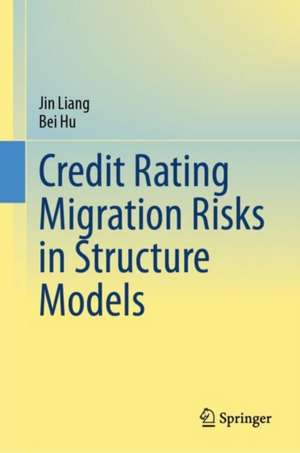Credit Rating Migration Risks in Structure Models
Autor Jin Liang, Bei Huen Limba Engleză Hardback – 5 iul 2024
The book first introduced the financial background and preliminary mathematical theory. Then two mainstream mathematical models for measuring default risks, the reduced form model and structure model, are presented. The structure model for measuring credit rating migration risks is the main part of the book and authors prove the existence, uniqueness, regularities, asymptotic behavior, traveling wave and other properties of the solutions of the model. The structural credit rating migration model is also extended to more general case, such as stochastic interest rate, multiple ratings, region switch and so on. Some credit derivatives, and numerical analysis, parameter calibration and estimate of the migration boundary of the models are given in the last two chapters.
The book focuses on theoretical financial investigators, especially financial mathematical researchers and students. The book is involved various mathematical models, such as PDE, numerical simulation etc., some of them are interesting mathematical problems, so that, and a good reference book to study mathematical modeling in credit rating migration. It might also be used as a textbook for students in financial credit risks.
Preț: 840.82 lei
Preț vechi: 1025.39 lei
-18% Nou
Puncte Express: 1261
Preț estimativ în valută:
160.89€ • 168.41$ • 133.91£
160.89€ • 168.41$ • 133.91£
Carte disponibilă
Livrare economică 10-24 martie
Preluare comenzi: 021 569.72.76
Specificații
ISBN-13: 9789819721788
ISBN-10: 9819721784
Pagini: 200
Ilustrații: IX, 277 p. 48 illus.
Dimensiuni: 155 x 235 x 22 mm
Greutate: 0.57 kg
Ediția:2024
Editura: Springer Nature Singapore
Colecția Springer
Locul publicării:Singapore, Singapore
ISBN-10: 9819721784
Pagini: 200
Ilustrații: IX, 277 p. 48 illus.
Dimensiuni: 155 x 235 x 22 mm
Greutate: 0.57 kg
Ediția:2024
Editura: Springer Nature Singapore
Colecția Springer
Locul publicării:Singapore, Singapore
Cuprins
Financial Background.- Preliminary Mathematical Theory.- Mathematical Models for Measuring Default Risks.- Markov Chain Approach for Measuring Credit Rating Migration Risks.- Application of Reduced Form/Markov Chain Credit Rating Migration Model.- Structure Models for Measuring Credit Rating Migration Risks.- Theoretical Results in the Structural Credit Rating Migration Models.- Extensions for Structural Credit Rating Migration Models.- Credit Derivatives Related to Rating Migrations.- Numerical Simulation, Calibration and Recovery of Credit Rating Boundary.
Notă biografică
Jin Liang, PhD of Applied Mathematics from Peking University, Professor in School of Mathematical Science, Tongji University. Her research interests focus on applications of PDE, especially on financial mathematics. She published more than 100 academic papers, including pricing financial derivatives, measuring credit risks, financial calculations, carbon reduction controlings etc. She is also a well-known popular science writer in China.
Bei Hu, Professor in University of Notre Dame, Department of Applied and Computational Mathematics and Statistics, is an expert in PDE and its applications. He published over 100 papers in a variety of aspects of PDE applications including Blowup Theory, Mathematical Biology, and Mathematical finance. In the past at the University of Notre Dame, he served as a department chair in the Department of Mathematics, department chair in the Department of Applied and Computational Mathematics and Statistics, Associate Dean in the College of Science. He also serves on the editorial board of several journals.
Bei Hu, Professor in University of Notre Dame, Department of Applied and Computational Mathematics and Statistics, is an expert in PDE and its applications. He published over 100 papers in a variety of aspects of PDE applications including Blowup Theory, Mathematical Biology, and Mathematical finance. In the past at the University of Notre Dame, he served as a department chair in the Department of Mathematics, department chair in the Department of Applied and Computational Mathematics and Statistics, Associate Dean in the College of Science. He also serves on the editorial board of several journals.
Textul de pe ultima copertă
The book provides the latest research results on measuring Credit Rating Migration by mathematical methods. It brings about most popular mathematical models, methods and applications on this area, especially presents the latest development on structure models. It is systematically collects the models, methods and results in this area.
The book first introduced the financial background and preliminary mathematical theory. Then two mainstream mathematical models for measuring default risks, the reduced form model and structure model, are presented. The structure model for measuring credit rating migration risks is the main part of the book and authors prove the existence, uniqueness, regularities, asymptotic behavior, traveling wave and other properties of the solutions of the model. The structural credit rating migration model is also extended to more general case, such as stochastic interest rate, multiple ratings, region switch and so on. Some credit derivatives, and numerical analysis, parameter calibration and estimate of the migration boundary of the models are given in the last two chapters.
The book focuses on theoretical financial investigators, especially financial mathematical researchers and students. The book is involved various mathematical models, such as PDE, numerical simulation etc., some of them are interesting mathematical problems, so that, and a good reference book to study mathematical modeling in credit rating migration. It might also be used as a textbook for students in financial credit risks.
Caracteristici
Provides new mathematical models and methods on measuring credit rating migration risks Presents the latest development on structure models Systematically collects the models, methods and applications on credit rating migration
